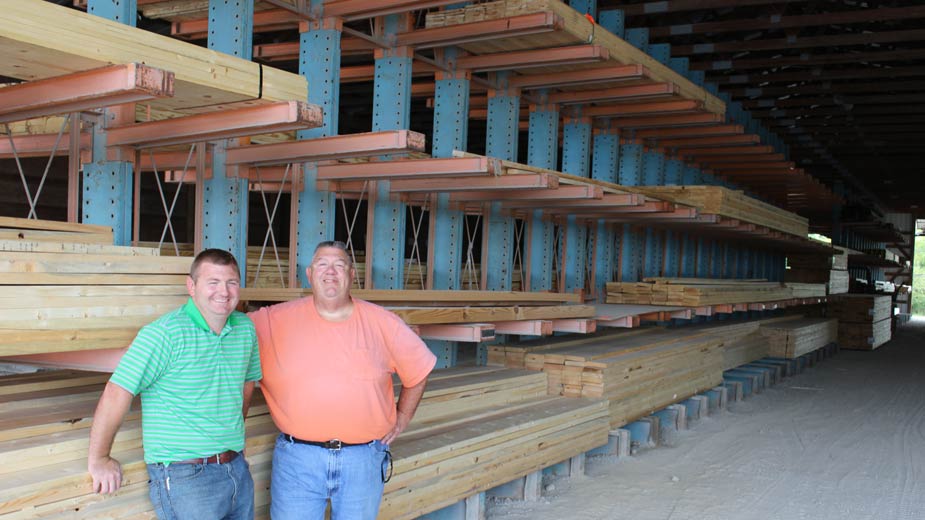Engineered Wood Products Gain Favor at Lumberyards
YOUNGSTOWN, Ohio — The materials needed to build a house or an office or a warehouse have changed little over the decades. At the most basic level, the men who construct buildings continue to hook lengths of wood together with bits of metal.
Just as in any other industry, though, there have been changes. Today, engineered wood products – structural pieces such as joists and trusses made from the scrap left over from processing – are gaining popularity against natural wood.
“This isn’t the tech industry and things take longer to develop. But there are always advancements,” says Mark Ely, director of marketing for Carter Lumber. “[Engineered wood products] are being used more because they can be custom designed inside to a degree to fit certain applications in the home and because they have structural benefits that similarly sized lumber does not have.”
By pressing wood scraps together into blocks and laminating them, the manufacturers better control the strength of the board. While knots, voids and uneven grain can affect the durability of an individual piece of lumber, engineered wood products, known in the industry as EWPs, always fall within the same range of strength.
“How strong it is and the knots [are] determined by nature, not by man,” says Don McConnell, owner of Hubbard Lumber. “Engineered wood products try to take that guesswork out of it to create a product [where] they can control the strength and durability.”
Bob Holmes, owner of M.E. Supply in Columbiana, says a popular engineered product is laminated veneer lumber, or LVL.
“It’s allowed builders to design the homes people want. Traditionally, you can’t get a beam of wood to carry what a LVL does,” he explains. “People like great rooms and open kitchens. LVLs can cover that 30-foot opening and keep it structurally sound.”
Adds Cody Holmes, outside sales manager at M.E. Supply, “Engineered wood products are a way to recycle what was traditionally thrown away or used for grade products like pallets.”
Because of those benefits, EWPs are gaining popularity in the industry, but McConnell notes that the pieces are more expensive than the traditional natural lumber he stocks.
As a commercial lumberyard – selling to contractors rather than do-it-yourself types – Hubbard Lumber stocks everything from EWPs to the traditional “two-by” pieces of lumber to supplies such as doors, windows and screws. Contractors tell him the projects they have coming up determine the lumberyard’s inventory.
“They don’t just decide to build a house tomorrow and order some lumber. It’s planned out. We know the planning stages, from drawing up blueprints to when loans are being sought out,” McConnell says. “He tells us they’re doing a 10,000-square-foot house with all two-by-12 joists, so we get an idea of what he needs before he digs the hole.”
But there are external forces as well that determine stock. With hurricanes Harvey and Irma destroying both houses and lumber in Texas and Florida – southern pine is one of the most common woods for construction – prices have risen sharply.
“When you’ve got a demand because 7,000 homes had their roofs blown off at one time, then suddenly supply is short and the prices go up,” McConnell says.
“We haven’t made any major lumber purchases in the last several months because [costs] are so high and the availability of the quality we get, of which there’s a finite amount anyhow,” Holmes adds. In this building season alone, lumber prices have risen 25%, he adds.
As part of a chain, Carter Lumber is able to get volume pricing for its stores, which cover the Midwest and lower Eastern seaboard. Within each market, Ely says, the regional vice president is responsible for ordering stock. But even within those dozen markets, though, the inventory may vary from store to store.
“The desire from our customers is different from market to market. The windows they buy in the Outer Banks [North Carolina] aren’t the same brand they buy in Charlotte,” he says. “What they buy in Cleveland may not be the same thing they buy in Akron.”
As a supplier to the construction business, lumberyards took a major hit during the Great Recession. Before 2008, McConnell says, lumber from his store was being used on five or six projects simultaneously.
Suddenly, if the builders he worked with had two projects in a year, they were lucky, he says. Where once there were dozens of independent lumberyards in northeastern Ohio, Holmes recalls, today there are fewer than 10.
For Carter Lumber, a conservative approach heading into the recession provided the opportunity to purchase lumberyards that were closing. It also led to the addition of new product lines, Ely adds. As the downturn began to end, contractors bought doors and windows but the supplies sat at the store for months because they didn’t have the framers to put up walls.
“We have 10 manufacturing plants now where we build roof trusses, floor trusses and wall panels,” he says. “That allows builders to buy all three. Instead of spending a week framing a home, they can take these, stand a wall up and nail it to the wall next to it.”
Pictured at top: Most of the business at M.E. Supply comes from contractors, say outside sales manager Cody Holmes and owner Bob Holmes.
Copyright 2024 The Business Journal, Youngstown, Ohio.


